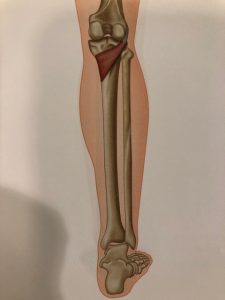There’s a little muscle behind your knee that the average joe hasn’t heard of. It’s often overlooked in knee pain relief simply because the quads and hamstrings get the spotlight. But the popliteus must be considered when discussing knee health.
Introducing the Popliteus
The popliteus unlocks the knee. Meaning when your knee is totally straight, the popliteus is the first muscle to bend it. So every step you take works the popliteus.

If you’ve ever had ACL repair surgery or other knee surgeries, there’s a good chance that the popliteus has been cut in the process.
The popliteus has a tendency to become neurologically overactive. Meaning the brain sends a lot of information to that muscle. When one muscle gets a lot of attention, another muscle(s) gets neglected. Then, a muscle imbalance develops.
Physical therapy after a surgery helps to prevent an imbalance from occurring. But if you’ve never had reason to go to PT, you wouldn’t know that an imbalance was developing. Pain is often your body’s only way of telling you that something is wrong. But the muscular imbalance is there often months or years before the pain sets in.
The popliteus gets overactive and often the rectus femoris (one of the 4 quad muscles) gets underactive. Though the hamstrings can become underactive too.
Knee Pain Relief
Treatment starts with muscle testing to identify if this muscle imbalance is happening. Visit the Neurokinetic Therapy directory to find a practitioner near you.
If the testing reveals this pattern, the first step is to massage the popliteus. Using your fingers, simply rub behind your knee for 1-2 minutes. Be cautious of the nerve that runs directly behind your knee. If you feel tingling, burning, or your foot falls asleep while you’re rubbing, you’re probably on that nerve. So stop for a few seconds, reposition, and continue massaging.
Then, follow with a strengthening exercise for the rectus femoris (quad.) I like the 4-phase leg raise. Lying on your back with both knees bent, feet flat on the floor.
1) Lift one leg only
2) Straighten that knee
3) Bend that knee
4) Lower leg, placing foot back on the floor
Those are the 4 phases. Repeat that exercise until your thigh feels fatigued. The amount of reps it takes to feel fatigued will be different for everyone.
Massage followed by strength on a daily basis for 2 weeks and you should feel some knee pain relief!
Further reading: if you have scars from knee surgery or any other surgery, check out this blog – Importance of Scar Tissue Massage

